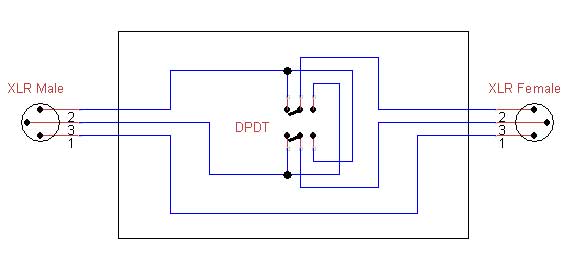Why a phase switcher?
We busk with two mics. We are typically 3 feet apart and the mics are around 1 foot in front of each of us.
We use only on busking amp with a single speaker.
Feedback occurs when the sound from the speaker reaches the mics in sufficient volume to be recycled and amplified
If we can place the speaker equidistant from both mics and invert one of the microphone signals, then sound from the speaker as seen by the mics should cancel out.
This does not of course cover sound bounced off ceilings, floor, wall, or anything else really. But playing in the open air, in a smallish confined area (busking!), with the speaker necessarily close to the mics, most of the feedback comes directly from the speaker.
The phase switch should allow us to turn up the volume further before feedback occurs.
The circuit is very simple

It will be neccesary to get the distances fairly accurate.
Let us say that the difference in distance beween the mics is 6inches or below. The effect of the mics cancelling out tends to roll off at a wavelength above 6 inches and be non existant at 3 inches.
The speed of sound in air is 1100 feet per second so these wavelengths translate to 2.2KHz and 4.4KHz. The close the distances are, the higher will be the feedback fequency.
It’s a Busking amp! not a hifi amp. High frequencies can be rolled off above 8KHz so if the distance can be set to 1.5 inches and the upper frequency limit rolled off then feedback should be much reduced. I suspect the speaker itself will roll off anyway. The power amp is flat to 20KHz so maybe it would be good to include some bandwidth limiting at its input.
Of course this is not perfect.There are “bounce paths” between the speaker and the mics’ including the floor, ceiling, walls, and the singers face. In rare cases phase reversing one mic may make it worse, but usually it should be better.
TESTS
It does work, but as the two mics I used ar not matched the effect was to move the feedback resonance higher up the frequency spectrum where the phase of the microphone output wrt the sound pressure input becomes apparent.
I have two Pyle mics (not matched, but the same model) and two matched condenser mics.
Let’s see.
The Pyle mics do suppress the feedback better (I can get more volume before feedback) but they are not very good for close miking as they accenuate S sounds.
The condenser mics (behringer C2s) were even better at feedback suppression but worse again for S sounds.
With none of the set ups could I turn the volume up far enough to hear my own voice through the amps at a distance of my mouth to the Mic of about 12 inches.
